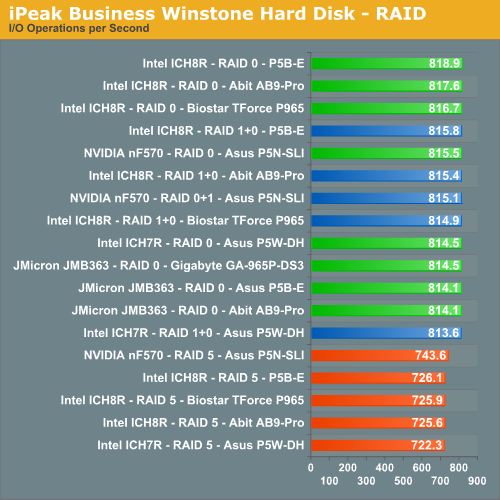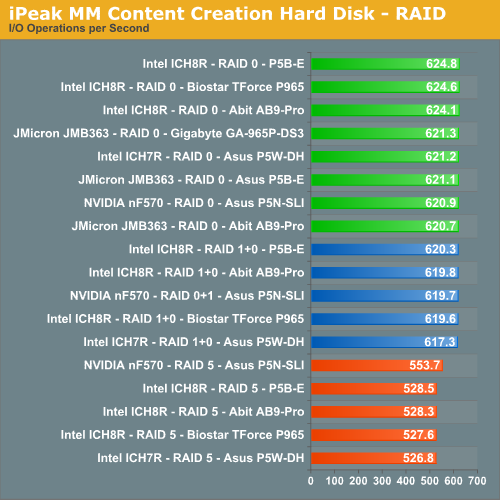Intel P965: Mid-Range Performance Sector Roundup
by Gary Key on October 20, 2006 9:00 PM EST- Posted in
- Motherboards
Disk Controller Performance - RAID
Due to the fact that we are testing two new chipsets in the form of the Intel ICH8R and JMicron JMB363 we decided to present a variety of RAID results in our P965 roundup. We utilize the same AnandTech iPeak test that is designed to measure "pure" hard disk controller performance. This consists of the Business Winstone 2004 and MCC Winstone 2004 benchmarks that provide a very good representation of general desktop performance. We also use the same Seagate 7200.10 Barracuda 320GB 7200 RPM SATA drive and average three test runs for the results. In our RAID 1+0 (10) and 0+1 testing, we utilize a four hard drive setup and a three drive combination for our RAID 5 testing.


In a reversal of our single drive tests we see the Intel ICH8R leading the NVIDIA nForce 500 controller in our RAID 0 and RAID 1+0 test results. While the NVIDIA controller still finished ahead of the older ICH7R we see enough improvements in both the ICH8R chipset and drivers to finish first. This surprised us and after running our tests on the ASUS P5N32-SLI Premium (nF590SLI Intel) motherboard we found NVIDIA back in first place with results about 2% better than the ICH8R. However, since this board was not available in time for our roundup the results stand with Intel placing first. We feel like our ASUS P5N-SLI board is just not performing up to par in these particular hard drive tests.
We see the JMicron JMB363 controller finishing behind both the NVIDIA and Intel chipsets in both RAID 0 tests resulting in a slight role reversal from our single drive results. In our Business Winstone test the JMicron results fall behind the ICH8R RAID 1+0 results and NVIDIA 0+1 tests compared to our single SATA drive tests where this controller almost finished first. After reviewing our test scripts we noticed that the 2% read performance advantage this chipset had over the Intel offerings in single drive testing was flipped to a disadvantage of around 1% in RAID 0. We feel like this is a driver issue as the JMicron performed very well in our Content Creation tests where it finished ahead of the NVIDIA chipset in RAID 0.
Our RAID 1+0 and 0+1 tests were slightly surprising as we did not expect our on-board controllers to perform as well as they did when compared to the RAID 0 setup. This is due to our Seagate test drive as our Western Digital 150GB Raptor setup on the same controllers typically showed a 2% to 4% advantage for the RAID 0 setup. Our RAID 5 results were not a surprise as the CPU overhead incurred from either the NVIDIA or Intel drivers generally result in dismal write performance when compared to dedicated hardware based solutions from Highpoint, Broadcom, or Areca.
What we did not expect was the NVIDIA controller performing up to 5% better in RAID 5 after reviewing the RAID 0, 1+0, and 0+1 results between the chipsets. The difference turned out to be improved write speeds with the NVIDIA controller especially in the Content Creation test. Our test scripts showed excellent read speeds from our native chipset based controllers but write speeds were sometimes up to 55% less than our HighPoint RocketRAID 2320 dedicated hardware controller we will be reviewing in the near future. We found the Intel Matrix software interface was generally easier to use to setup up our various RAID arrays although the revised NVIDIA control panel with the nForce 500 series is significantly better now.
Due to the fact that we are testing two new chipsets in the form of the Intel ICH8R and JMicron JMB363 we decided to present a variety of RAID results in our P965 roundup. We utilize the same AnandTech iPeak test that is designed to measure "pure" hard disk controller performance. This consists of the Business Winstone 2004 and MCC Winstone 2004 benchmarks that provide a very good representation of general desktop performance. We also use the same Seagate 7200.10 Barracuda 320GB 7200 RPM SATA drive and average three test runs for the results. In our RAID 1+0 (10) and 0+1 testing, we utilize a four hard drive setup and a three drive combination for our RAID 5 testing.


In a reversal of our single drive tests we see the Intel ICH8R leading the NVIDIA nForce 500 controller in our RAID 0 and RAID 1+0 test results. While the NVIDIA controller still finished ahead of the older ICH7R we see enough improvements in both the ICH8R chipset and drivers to finish first. This surprised us and after running our tests on the ASUS P5N32-SLI Premium (nF590SLI Intel) motherboard we found NVIDIA back in first place with results about 2% better than the ICH8R. However, since this board was not available in time for our roundup the results stand with Intel placing first. We feel like our ASUS P5N-SLI board is just not performing up to par in these particular hard drive tests.
We see the JMicron JMB363 controller finishing behind both the NVIDIA and Intel chipsets in both RAID 0 tests resulting in a slight role reversal from our single drive results. In our Business Winstone test the JMicron results fall behind the ICH8R RAID 1+0 results and NVIDIA 0+1 tests compared to our single SATA drive tests where this controller almost finished first. After reviewing our test scripts we noticed that the 2% read performance advantage this chipset had over the Intel offerings in single drive testing was flipped to a disadvantage of around 1% in RAID 0. We feel like this is a driver issue as the JMicron performed very well in our Content Creation tests where it finished ahead of the NVIDIA chipset in RAID 0.
Our RAID 1+0 and 0+1 tests were slightly surprising as we did not expect our on-board controllers to perform as well as they did when compared to the RAID 0 setup. This is due to our Seagate test drive as our Western Digital 150GB Raptor setup on the same controllers typically showed a 2% to 4% advantage for the RAID 0 setup. Our RAID 5 results were not a surprise as the CPU overhead incurred from either the NVIDIA or Intel drivers generally result in dismal write performance when compared to dedicated hardware based solutions from Highpoint, Broadcom, or Areca.
What we did not expect was the NVIDIA controller performing up to 5% better in RAID 5 after reviewing the RAID 0, 1+0, and 0+1 results between the chipsets. The difference turned out to be improved write speeds with the NVIDIA controller especially in the Content Creation test. Our test scripts showed excellent read speeds from our native chipset based controllers but write speeds were sometimes up to 55% less than our HighPoint RocketRAID 2320 dedicated hardware controller we will be reviewing in the near future. We found the Intel Matrix software interface was generally easier to use to setup up our various RAID arrays although the revised NVIDIA control panel with the nForce 500 series is significantly better now.










62 Comments
View All Comments
smn198 - Monday, October 23, 2006 - link
Would you be able to re-run using 4 drives for all of the tests please?
jonp - Sunday, October 22, 2006 - link
-- “…budget sector and includes boards from ECS, Foxconn, Intel, and Gigabyte.” – will the MSI P965 Neo-F be in this set?-- the Abit AB9 Pro feature set does not show the eSata port on the SI 3132 (two SATA). it does show a serial port on the i/o panel but not one in the picture.
-- The Biostar feature set shows 4 USB on the i/o panel when there are six in the picture.
JarredWalton - Sunday, October 22, 2006 - link
Fixed - thanks.powchi - Saturday, October 21, 2006 - link
Can I use a 20-pin power supply on these boards since all are using 24-pin connectors? Or will I be needing 20pin to 24pin adaptor?The PSU is an Enermax NoiseTaker EG475P-VE SFMA 470W ATX 12V v1.3.
Aikouka - Sunday, October 22, 2006 - link
Some motherboard manufacturers will no longer support your motherboard if they find out you've been running it with a 20-pin ATX plug or a 20->24-pin adapter. Just be safe and get a newer PSU :). I know DFI will no longer support the motherboard if it specifically asks for a 24-pin.JarredWalton - Saturday, October 21, 2006 - link
Technically, yes you can use 20-pin PSUs. Will they work, and will the system be stable? That varies. I haven't had any issues on the systems where I've done it, but if you do high overclocking it will likely become a serious issue.powchi - Saturday, October 21, 2006 - link
Jarred,So there's no need to use a 20pin to 24pin adaptor? What are the differences when using and not using an adaptor? Thanks.
lopri - Sunday, October 22, 2006 - link
No. As a matter of fact, the adapter should be avoided. Just plug the 20-pin connector to 24-pin receptacle with 4-pin left empty. Like Jarred said, it should work in theory and it does in practice. However, the quality of PSU and how intense is one's OC can affect the (long-term) stability.JarredWalton - Sunday, October 22, 2006 - link
I suppose the adapter *could* help, as it ensures power is available on all the 24-pins, but you're still taking the power from the same source so depending on how that works out it can actually make things worse. I would typically say that if you have a 400W or better PSU you should be fine with little to moderate OC'ing even with 20-pins. (I have an OCZ ModStream 450W that certainly works fine in a 939 board with a decent 2.0 to 2.6 GHz overclock.)lopri - Sunday, October 22, 2006 - link
Yes! Not to brag about myself or anything, but I went through countless Socket 939 Opterons on DFI NF4 SLI-D with original Antec TruePower EPS12V (20-pins, not the TP2 with 24-pins) including an Opteron 165 @3.0GHz (9x333). TCCD up to 325MHz/2.5-4-3-8! The setup was absolutely stable.